Physical Address
304 North Cardinal St.
Dorchester Center, MA 02124
Physical Address
304 North Cardinal St.
Dorchester Center, MA 02124
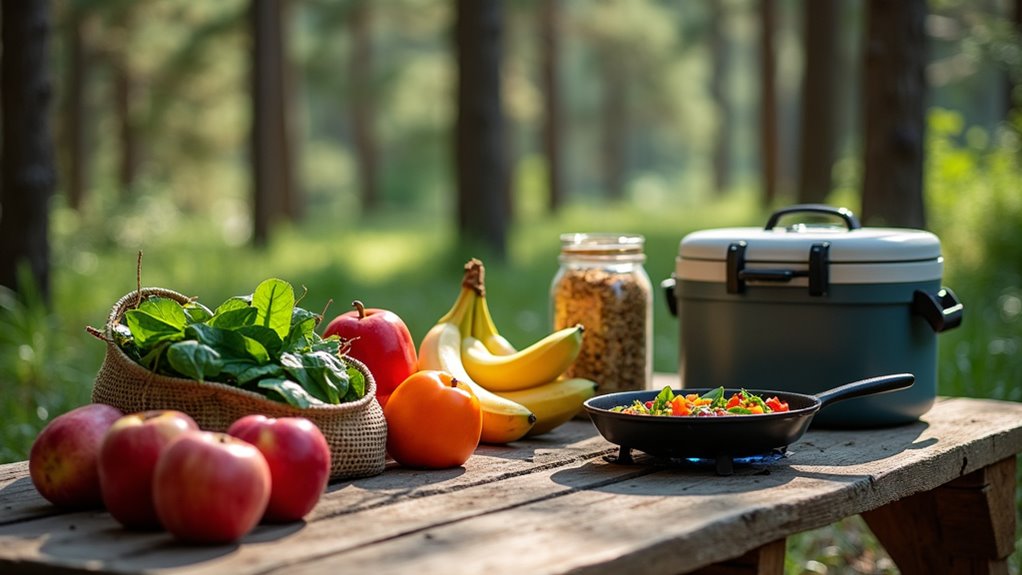
Camping doesn't mean compromising your nutrition—discover clever strategies to fuel your outdoor adventures with wholesome, energizing meals that actually taste amazing.
You’ve probably experienced the camping food dilemma: you want to maintain your healthy eating habits, but you’re stuck with processed snacks and instant meals that leave you feeling sluggish on the trail. The good news? You don’t have to sacrifice nutrition for convenience when you’re outdoors. With the right strategies and a bit of preparation, you can fuel your body properly while enjoying nature’s playground. Here’s how to transform your camping kitchen into a source of energy and vibrancy.
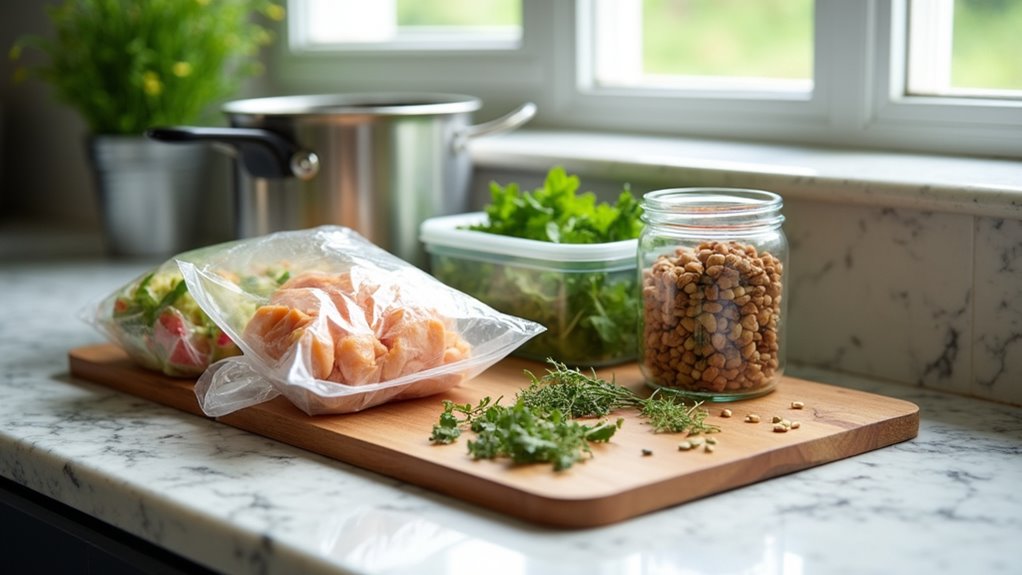
Before you pack your tent and sleeping bag, you’ll want to map out your camping menu and tackle the prep work in your kitchen at home.
Start by creating a meal plan for each day, considering your group’s dietary needs and activity levels.
Plan meals thoughtfully by assessing your group’s dietary restrictions, preferences, and how much energy you’ll burn during activities.
Chop vegetables, marinate proteins, and portion out snacks into containers or bags.
Pre-cook items like hard-boiled eggs, quinoa, or grilled chicken that’ll work in multiple dishes.
Freeze soups and stews in zip-top bags – they’ll thaw perfectly by mealtime while keeping other foods cold.
Mix dry ingredients for pancakes or trail mix ahead of time.
Label everything with contents and dates.
This advance preparation saves precious camping time and guarantees you’ll actually eat those healthy foods instead of reaching for processed convenience items.
What camping foods can sustain your energy without requiring refrigeration? Focus on protein-rich options like nuts, seeds, jerky, and canned fish. These’ll keep you satisfied longer than sugary snacks.
Pack whole grains such as quinoa, brown rice, and oats – they’re filling and provide steady energy release.
Don’t forget legumes like lentils, chickpeas, and black beans. They’re protein powerhouses that store easily.
Dried fruits offer natural sweetness plus vitamins, while nut butters deliver healthy fats and protein.
Choose nutrient-dense options over empty calories. Instead of chips, grab trail mix with nuts and dried fruit. Swap white bread for whole grain crackers.
These swaps maximize nutrition while minimizing pack weight, ensuring you’ll fuel your adventures properly without compromising your health goals. When venturing into wooded areas to forage or explore, remember that proper preparation includes learning about tick bite prevention to keep your outdoor adventures safe and enjoyable.
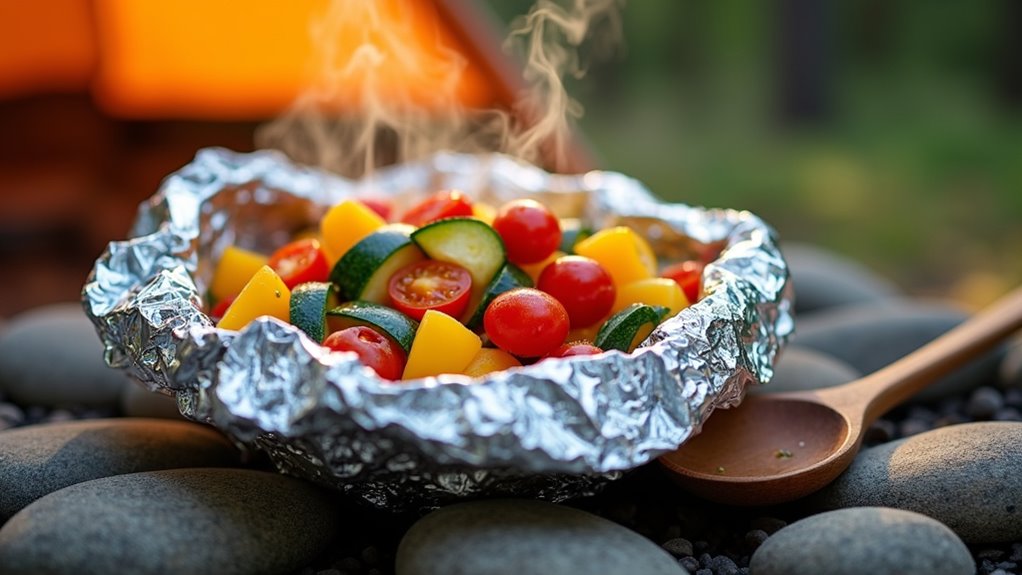
While non-perishable staples form your camping nutrition foundation, you’ll want fresh vegetables to round out your meals and add essential nutrients. Foil packet cooking transforms fresh produce into delicious campfire meals without requiring multiple pots or complicated cleanup.
Create individual packets using heavy-duty aluminum foil. Layer chopped vegetables like bell peppers, zucchini, onions, and carrots inside each packet. Add olive oil, salt, pepper, and herbs for flavor. Seal packets tightly by folding edges multiple times to prevent steam from escaping.
Place packets directly on hot coals or your camp grill for 15-20 minutes, turning once halfway through. The steam-cooking method preserves nutrients while developing rich, smoky flavors.
You can customize each packet with different vegetable combinations, making everyone happy while maintaining your healthy eating goals.
Although foil packets work wonders for vegetables, you’ll need a reliable cooler system to keep fresh ingredients safe and extend your healthy meal options beyond the first day. Invest in a high-quality cooler with thick insulation and tight seals.
Pack frozen water bottles or gel packs at the bottom, then layer raw meats separately from other foods. Place dairy and produce on top where temperatures stay most consistent.
Pre-chill everything before packing, and keep your cooler in shade whenever possible. A two-cooler system works best—one for beverages you’ll access frequently, another for food storage you’ll open less often. This prevents temperature fluctuations that spoil fresh ingredients and compromise your healthy camping meals.
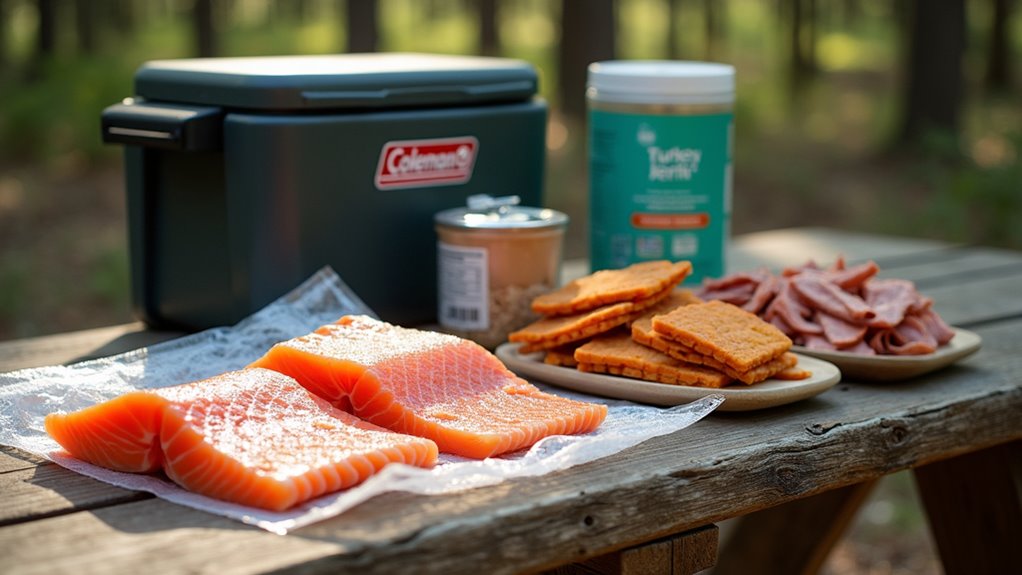
Since protein forms the foundation of satisfying meals that keep you energized on the trail, you’ll want to select options that won’t spoil quickly in outdoor conditions. Pre-cooked chicken strips, hard-boiled eggs, and canned fish like salmon or tuna offer excellent protein without requiring immediate refrigeration.
Turkey jerky and beef jerky provide portable options that last for days without cooling.
For longer trips, consider shelf-stable proteins like canned beans, lentils, or chickpeas that pack well and offer plant-based nutrition.
Nuts and seeds deliver healthy fats alongside protein while requiring zero preparation.
If you’re bringing a cooler, lean ground turkey or pre-marinated chicken thighs cook quickly over camp stoves.
These protein choices help maintain your energy levels while preventing food safety issues during outdoor adventures. When planning your protein selections, remember that proper food storage is crucial for beginners to ensure both nutrition and safety throughout your camping experience.
One-pot meals transform camping nutrition by combining your carefully selected proteins with vegetables, grains, and seasonings in a single cooking vessel. You’ll minimize cleanup while maximizing flavor and nutrients.
Start with a base of quinoa, brown rice, or whole wheat pasta, then add your lean proteins and colorful vegetables. Try a Mediterranean chickpea stew with tomatoes, spinach, and feta, or create a hearty chicken and vegetable rice pilaf.
Build your camping meal foundation with nutrient-dense grains, then layer in lean proteins and vibrant vegetables for complete nutrition.
Season generously with dried herbs, garlic powder, and spices you’ve pre-mixed at home. Cook everything in your largest pot or Dutch oven, adding ingredients at different times to ensure proper texture.
You’ll have a complete, balanced meal with just one dish to wash. These camping recipes offer both simplicity and taste, making them perfect for outdoor cooking adventures.
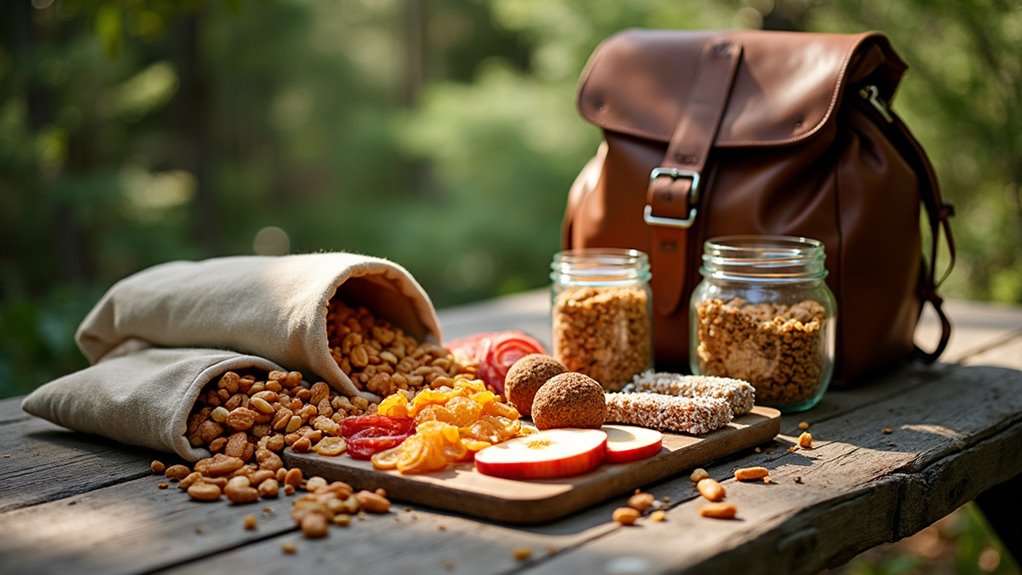
When you’re hiking miles from your campsite, your energy levels depend entirely on the snacks you’ve packed in your backpack. Smart trail snacking means choosing foods that’ll sustain you without weighing you down or spoiling in heat.
Focus on nutrient-dense options that combine protein, healthy fats, and complex carbs. These combinations provide steady energy release rather than quick sugar spikes that leave you crashing later.
Pack these powerhouse snacks for sustained trail energy:
Pre-portion everything into small containers or bags to control serving sizes and prevent overeating on the trail.
Remember that staying properly hydrated enhances nutrient absorption from your trail snacks, so pair your healthy eating strategy with adequate water consumption throughout your outdoor adventure.
Every hour of outdoor activity increases your body’s demand for fluids, making proper hydration your most critical camping health priority. You’ll need more water than usual when hiking, setting up camp, and orienting yourself to temperature changes. Pack at least one gallon per person daily, plus extra for cooking and cleaning.
Don’t rely solely on plain water for extended activities. You’re losing essential minerals through sweat that need replacement. Add natural electrolytes by mixing a pinch of sea salt into your water bottle, or pack coconut water for potassium and magnesium. Fresh lemon or lime juice provides vitamin C while enhancing flavor.
Monitor your urine color—pale yellow indicates proper hydration. Dark yellow means you’re behind on fluid intake and need immediate attention. Consider using an intelligent water bottle that tracks your hydration levels throughout the day to ensure you’re meeting your fluid intake goals during outdoor activities.
You’ve now got a treasure trove of healthy camping strategies in your back pocket! Don’t let the great outdoors derail your nutrition goals – with these eight game-changing tips, you’ll fuel your adventures like a champion. Remember, preparation is your secret weapon, and smart food choices are your compass. So pack those coolers, fire up that camp stove, and show Mother Nature that eating well isn’t just for city folk!